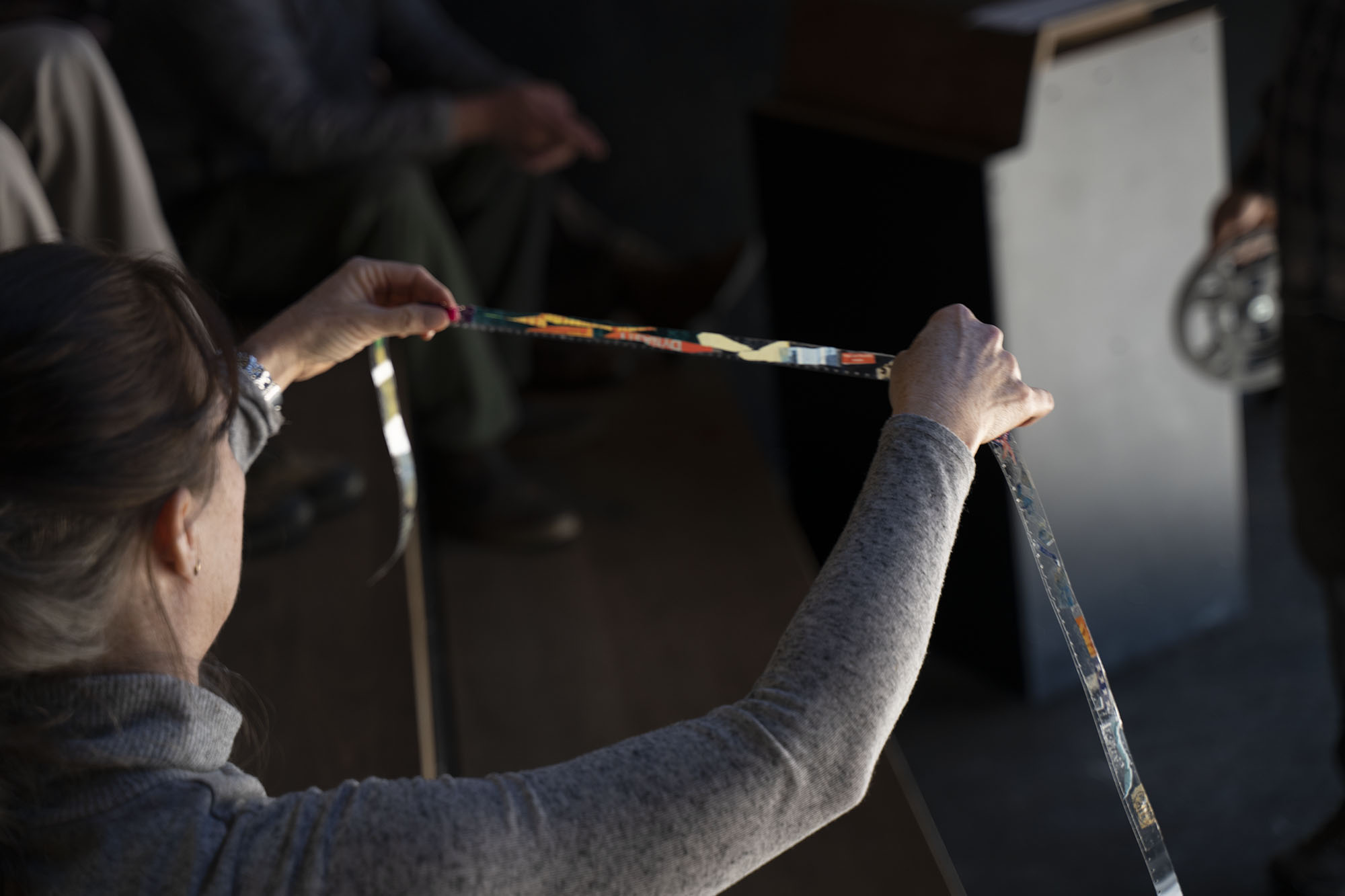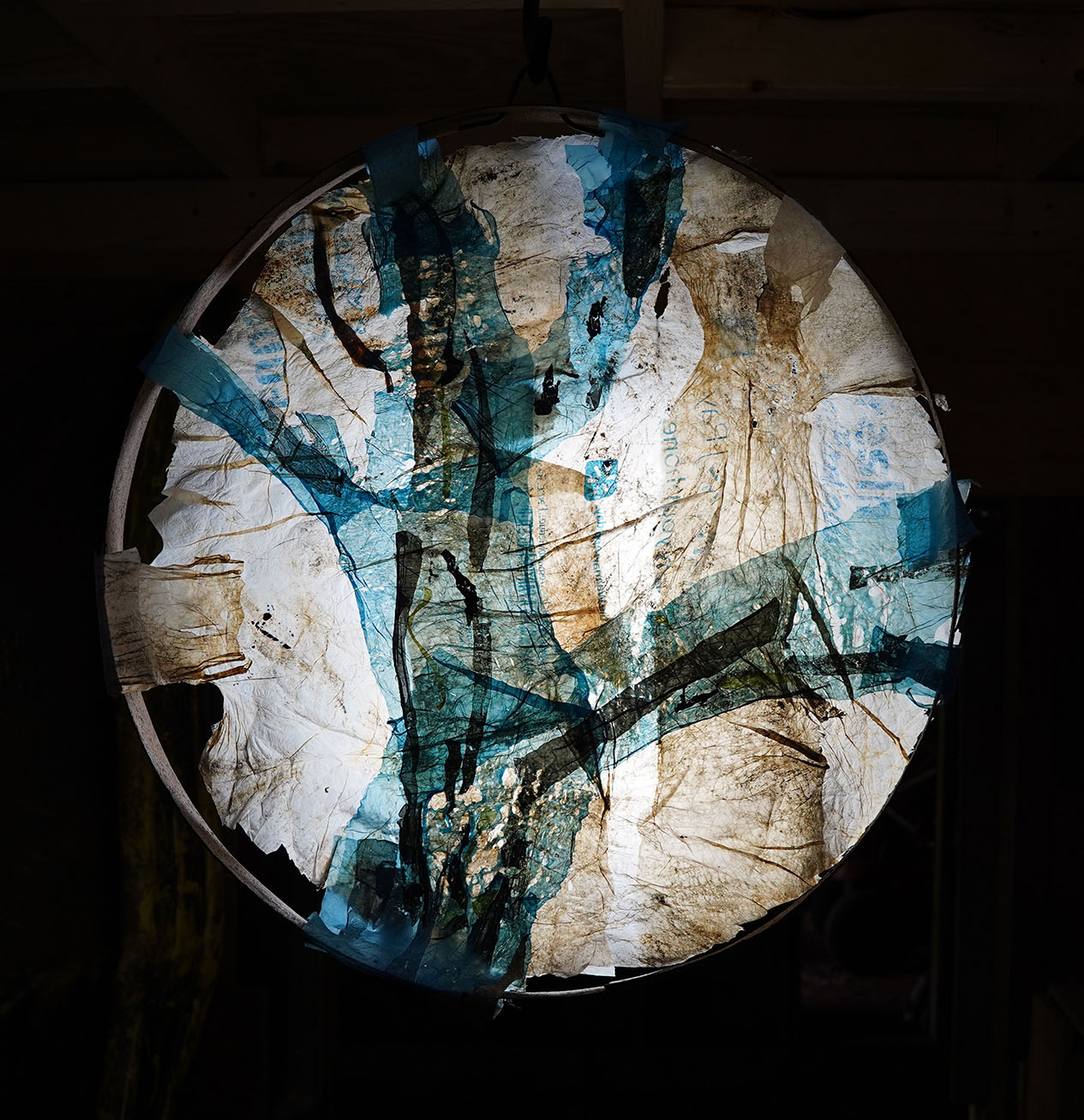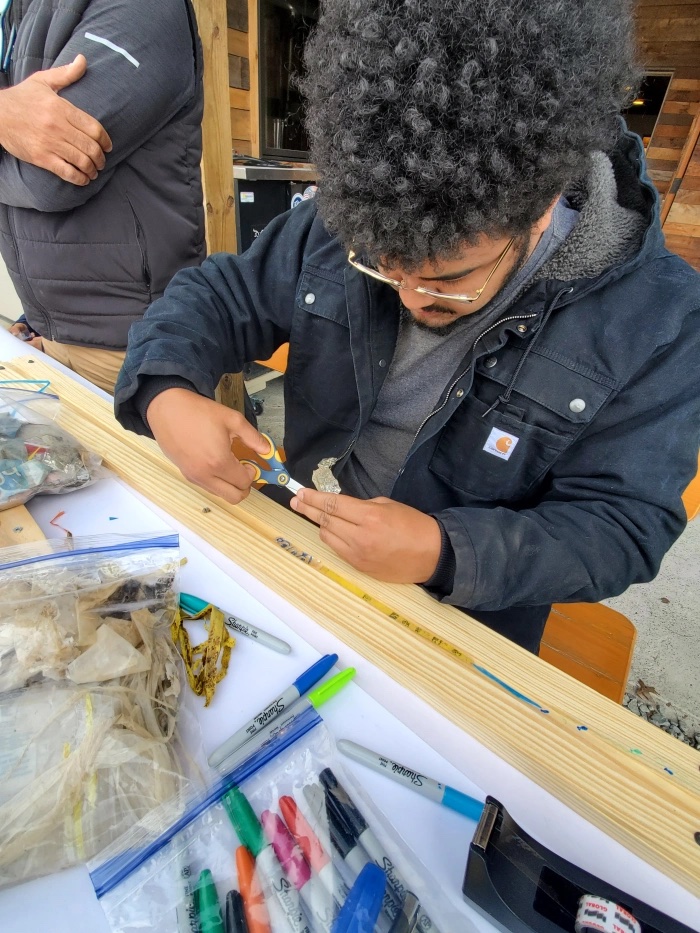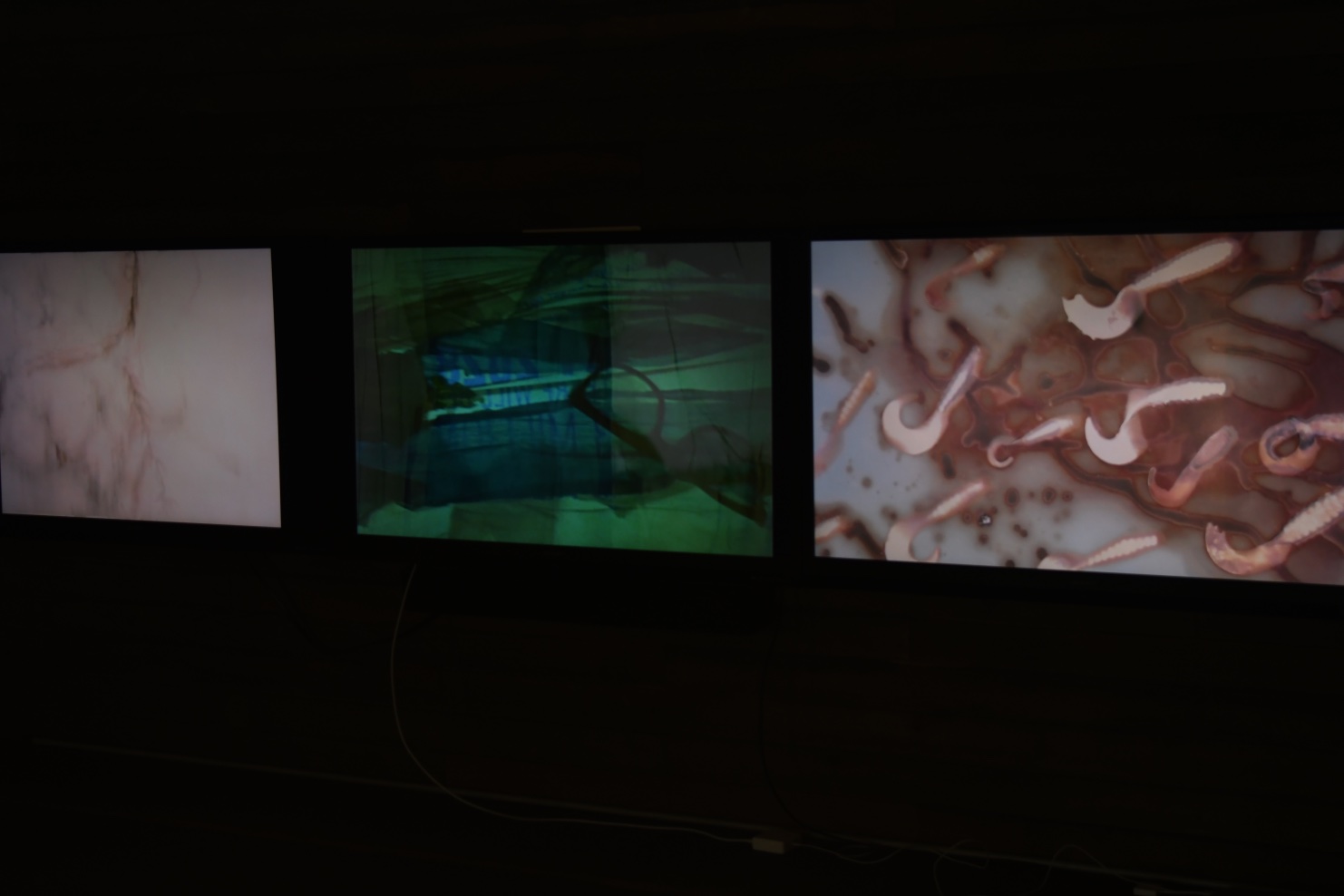
Plastic Confluence series from Trash Trout Picture Show exhibit at the Blowing Rock Art and History Museum in 2022. Photo by Lauren Armbrust, courtesy of BRAHM.
Interview by Olivia Ann Carye Hallstein
Tom Hansell uses a collaborative process within rural communities to create work that supports both natural and local cultures in North Carolina, and soon, Utah. Through the medium of experimental film and live performance or soundscapes, Tom shines light on the implications of plastic waste in the regions. His work impacts, honors, integrates and advocates his surroundings directly.
 Participants at a workshop sponsored by the New River Conservancy, 2022
Participants at a workshop sponsored by the New River Conservancy, 2022
You have such an impressive body of work, but for today, I'd like to focus on your more recent projects. Let's start with "The Ancient New," which is a collaboration between yourself, other artists, community members and organizations within the New River Valley. Even the title contrasts current and historic impacts on this riverway environment and on local communities. What has the collaborative nature of this work taught you and what have the resulting conversations brought to fruition?
“What you do to the land, you do to the people” is a saying I have often heard while working in rural Appalachian communities. "The Ancient New" is designed to gather people together to better understand our connections to the land and water that sustain us. Over the past decade of working on this project, I’ve learned about impacts of agriculture, industrial development, and tourism. I’ve learned that the New River feeds the Ohio River, which provides drinking water to more than five million people and demonstrated how water connects us. I’ve also met an inspiring number of people who are working on innovative ways to sustain their home place.

Plastic Confluence #3, plastic shopping bags and barrel hoop savaged from the New River, 2022
You seem to be building these connections in your process as well by collecting plastic refuse directly in the landscape. How does your collection process influence how you approach the creation of your work?
I have always collected trash while hiking, paddling, and fishing. The idea for "The Trash Trout Motion Picture Show" came after participating in organized river clean ups and having conversations with other volunteers about how many people choose not to see the plastic and other refuse that ends up in creeks and rivers. My films such as "The Trash Trout Motion Picture Show," "Benthic Salvage," and "Does Water Die?" are all attempts to put a spotlight on the waste that is generated from society’s increasing appetite for consumption.
These films are part of a long-term project title "The Ancient New." For the next phase of this project, I am collaborating with grassroots organizations to produce a series of community festivals that use moving images and live performances to bring folks together, bridge cultural or political divisions, and celebrate the water that connects us to each other.
In order to bring all of these topics together you are using some new stylistic choices for this piece. Previously, you used a documentary style approach (ex. “After Coal” from 2016 that compares mining communities in Kentucky, USA and Wales, UK), but your more recent approach to riverway plastic materials, on the other hand, embraces an experimental filmmaking approach. What have you noticed comparing both processes? And what has the difference in impact been using each approach?
I moved toward experimental filmmaking after realizing how heavily my documentaries relied on the spoken word to create meaning. I wanted to strengthen my visual storytelling skills by making films that did not require language to communicate meaning. The challenge is that experimental films are more difficult to distribute, which can decrease the impact of the work. However, the participatory process I use for films such as the "The Trash Trout Motion Picture Show" offers an opportunity to deepen the experience of local people who are part of the project. For example, the town of Boone, North Carolina, the Watauga Riverkeeper and New River Conservancy helped coordinate the cleanup efforts and workshops that created the film. More than 50 volunteers taped trash to film strips to create the visual elements of "The Trash Trout Motion Picture Show" and directly experienced the impacts of plastic pollution.

Participants at workshop at the Appalachian Mountain Brewery, March 22, 2022
Let's talk more about your work “The Trash Trout Motion Picture Show.” It integrates experimental film composition using plastic with nature sounds and Appalachian music and dance performances by taping found plastics onto film, you are able to replicate water texture and flow. What inspired you to pair this music and audio with your visual work? What does sound choice contribute to your films in the form of metaphor?
"The Trash Trout Motion Picture Show" uses the power of music, dance, and film to reveal human connections to fresh water. I collaborated with traditional Appalachian musician Trevor McKenzie and musician / dancer Julie Shepherd–Powell to create a soundtrack that reflects the landscape and the cultures of the New River.
Trevor McKenzie relied on his deep knowledge of historic musicians who lived and worked in communities along the river to arrange a medley of traditional songs including "Waterbound," "New River Train," and "The East River Mountain Blues." The musical selections follow the river’s flow, starting with songs from from western North Carolina before moving to southwestern Virginia and on to West Virginia. These regions are where the New becomes the Kanawha and empties into the Ohio River.
Julie Shepherd–Powell brought her experience performing the Appalachian flatfoot dance style that is a vibrant part of mountain communities. She explains that dance is a “multi-generational and welcoming practice that encourages participation from young and old, accomplished and amateur, and local and visiting dancers alike.” The percussive elements of the dance mesh with the sound of the 16mm film projector, fiddle, and banjo to provide multiple paths for the audience to understand their personal connection to the river.
Trash Trout Boonerang Sample from Tom Hansell on Vimeo.
“Trash Trout Motion Picture Show”, live performance with Trevor McKenzie and Julie Shephard-Powell, activated experimental film installation, Boonerang Festival, June 17, 2022
And, just like the river, these multiple paths lead to a common junction. Especially in “Does Water Die?,” the local landscape seems to be a primary theme. What are your foremost concerns related to waste on your local North Carolina environment? And what is filmmaking’s unique impact in this advocacy?
Many people consider North Carolina’s Blue Ridge Mountains, where I live, to be a pristine environment. However, while making "The Trash Trout Motion Picture Show," I learned that microplastics have been found in every surface water sample from our region. The mountains in my home county are the headwaters of three major river systems that feed the Ohio and Mississippi Rivers as well as the Atlantic Ocean. Protecting water quality in headwaters communities will help millions of people downstream.
Locally, my goal is to support my project partners who are advocating for a plastic bag ban. Plastic bags have been banned in many parts of the US, Canada, and Europe, but not in North Carolina. Emerging research shows that microplastics have been found in human blood and can potentially impact public health. I hope my films can raise questions, start conversations, and energize people to seek solutions. My ultimate goal is to help create positive feedback loops between geographic place, human cultures, and natural systems.

Three Channel Installation for the 2022 New River Symposium at Bechtel Summit Reserve’s Sustainability Treehouse, Glen Jean, West Virginia
And the work is expanding to other locations to create those feedback loops! In fact, you spent the month at the Moab Arts Reuse Residency in Utah projecting experimental films onto upcycled materials. What parallels did you notice between harmful pollutants and the natural environment through material use? What are your goals in this new environment?
The Moab Arts Reuse Residency provided me the opportunity to collaborate with community members to make a series of short, crowd sourced films about the waste stream in this part of Utah. Uranium mining has left a lasting legacy on the local landscape, and the explosion of tourism in recent years has created new issues with waste disposal. During my residency, we focused on three aspects of Moab’s waste stream: I partnered with the Canyonlands Solid Waste Authority to create a short film about municipal waste and recycling, worked with Moab’s Sustainability Department to create a film about composting food waste, and collaborated with local residents to make a piece about the federal government’s efforts to remediate radioactive waste from an old uranium mine.
I also salvaged broken flat screen televisions and stitched the screens together to create a 12 foot by 7 foot screen to show the films to the community. My goal for this residency was to amplify conversations about how to make Moab’s waste stream more sustainable. I concluded the residency by screening the short film series, titled "Moab Waste Stream," to the community on August 30 of this year.
I am excited to see how this continues to develop. Thank you, Tom!
Does Water Die? from Tom Hansell on Vimeo.
“Does Water Die?” Tom Hansell & Joshua White, experimental film made with plastic waste from New River. 2019